The Woodpeckers of the Eastern Texas Pineywoods


The eastern Texas Pineywoods supports more species of woodpeckers than any other region of the state.
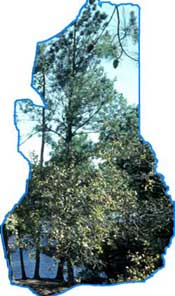
Currently, eight species of this unique family of birds exist in the Pineywoods. The Ivory-billed woodpecker once lived in eastern Texas, bringing the list up to nine. In general, woodpeckers require older trees and snags (dead trees) for feeding and nesting. Conservation of our mature forests and urban woodlots will ensure habitat for these important birds, as well as other species of wildlife dependent on their cavities.
Each species photo and caption underneath links to line art drawings of both the male and female of each bird species.
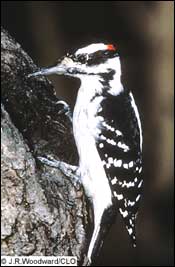
Hairy Woodpecker
(Picoides villosus)
Photo by J.R. Woodward, © 2004-2005, Cornell Lab of Ornithology
Hairy Woodpecker
(Picoides villosus)
An almost robin-sized (9 1/4") black and white woodpecker with a white back and a fairly long bill. Uncommon in both open and dense woods, especially along the edges.
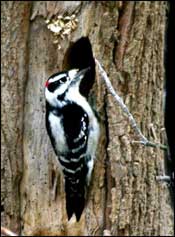
Downy Woodpecker
(Picoides pubescens)
Photo by David Cappaert, USDA Forest Service
www.forestryimages.org
Downy Woodpecker
(Picoides pubescens)
A sparrow-sized (6 3/4") woodpecker that is distinguished from the identical Hairy Woodpecker by its smaller size and shorter bill. Very common in suburbs, orchards, parks and woods.
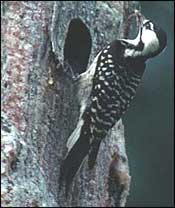
Red-cockaded Woodpecker
(Picoides borealis)
Red-cockaded Woodpecker
(Picoides borealis)
This endangered woodpecker is found in old, open pine forests. Creates nest cavities in living pine trees. Holes for pine resin to ooze are created in cavity trees to prevent snakes from climbing the tree. Males have a small red patch of feathers located near the ear (or cockade), which is rarely seen in thefield. Also called RCW, this species is about the size of an eastern bluebird (8 1/2").
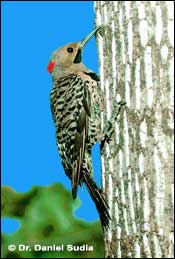
Northern Flicker
(Colaptes auratus)
Photo © Dr. Daniel Sudia
Florida Museum of Natural History
Northern Flicker
(Colaptes auratus)
A large, jay-sized (12 1/2") brownish woodpecker with a white rump and flashes of yellow in wings and tail. Nests in large trees in open forests, parks, and suburban areas. Spends much of its time searching for food on the ground. Prefers hardwood forests and lawns in the fall and winter.
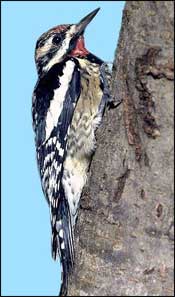
Yellow-bellied Sapsucker
(Sphyrapicus varius)
Photo Courtesy Emory College
Yellow-bellied Sapsucker
(Sphyrapicus varius)
A common, but quiet bluebird-sized (8 1/2") woodpecker that drills horizontal rows of small holes in live trees. Found in pine and hardwood forests, as well as in parks, yards, and gardens. A winter resident, this species is not here in the summer.
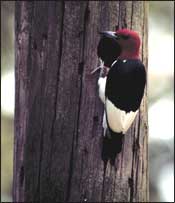
Red-headed Woodpecker
(Melanerpes erythrocephalus)
Red-headed Woodpecker
(Melanerpes erythrocephalus)
A robin-sized (9 1/4") black and white woodpecker with an entire red head. Found in the spring and summer in open forests, such as golf courses, parks, and farms. In winter, can be found in bottomland hardwoods in search of acorns. Young birds have gray heads in fall and winter, acquiring the red by spring.
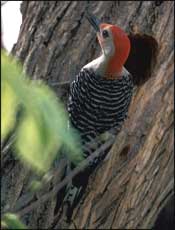
Red-bellied Woodpecker
(Melanerpes carolinus)
Red-bellied Woodpecker
(Melanerpes carolinus)
This robin-sized (9 1/4") woodpecker is the most common and widespread woodpecker in this region. Found in all types of forests, as well as suburbs and parks. The name is misleading since the small red belly patch is rarely seen.
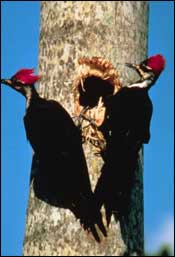
Pileated Woodpecker
(Dryocopus pileatus)
Photo Courtesy USDA Forest Service –North Central Research Station Archives
www.forestryimages.org
Pileated Woodpecker
(Dryocopus pileatus)
A large (16 1/2"), noisy, crow-sized black woodpecker with white neck stripes and chin. The prominent red crest and white under-wing linings aid in identification. Prefers extensive forests and mature trees for nesting, but is also found in smaller woodlots, yards and parks. Colloquial names include: Indian hen, log-god or by-god.
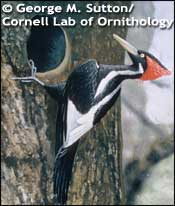
Ivory-billed Woodpecker
(Campephilus principalis )
Photo Courtesy George M. Sutton, © 2004-2005, Cornell Lab of Ornithology
Ivory-billed Woodpecker
(Campephilus principalis )
May be extinct. No confirmed sightings in entire U.S. range in over 50 years. The white bill and extensive white on the wing distinguish it from the Pileated woodpecker. Requires a continual supply of dead or dying trees for foraging. Rediscovered in Cuba in 1986 but their existence there is uncertain. The few individuals seen there in the 1980's could be the last individuals to exist in the world. (19 1/2")
Wildlife Diversity Program
Texas Parks and Wildlife Department
4200 Smith School Road
Austin, TX 78744
or send a message to: nature@tpwd.state.tx.us
 (
(